Between Industrialism and Postindustrialism—the Case of Small Towns in a Large Urban Region: The Katowice Conurbation, Poland
Abstract
1. Introduction
2. Methodology
3. Specific Features of the Katowice Conurbation’s Economic Transformation
4. Lędziny and Radzionków—Similar Functional Origins, Different Present Development
5. Towards a Functional Model of a Small (Post)Mining Town
6. Discussion
- -
- Gwosdz [83] distinguished six different models of path dependence—partly as a consequence of reaction to the ‘shock of transformation’ (positive–self-reinforcing, positive–reactive, positive–other, negative–self-enforcing, negative–reactive, and negative–other);
- -
- different rates of population changes (1990–2018)—while cities such as Bytom, Katowice and Sosnowiec lost more than 20% of the population during this period, some towns (Imielin, Mikołów) have even recorded a small increase; and
- -
- in the case of small towns, the ‘David against Goliath’ phenomenon (localization of the first zones of the Katowice Special Economic Zone in bigger towns, competition about specialized function between the bigger and the medium size towns, and also between the medium size towns and the small towns).
7. Conclusions
- -
- towns in which mining has worse chances for further growth, and other functions have not yet emerged for various reasons;
- -
- postindustrial towns in which coal mine closure did not cause positive reactions, like in Radzionków;
- -
- towns that, following the fall of coal mining, placed their bets on the processing industry or logistics; and
- -
- towns in which the residential function is key.
Author Contributions
Funding
Conflicts of Interest
References
- Heffner, K.; Marszał, T. (Eds.) Problemy Rozwoju Małych Miast w Wymiarze Lokalnym i Regionalnym (Problems of Development of Small Towns on Local and Regional Dimension); Komitet Przestrzennego Zagospodarowania Kraju PAN: Warszawa, Poland, 2005. [Google Scholar]
- Burdack, J.; Knappe, E. The development of small towns in central Europe and the Baltic states. Ģeog. Raksti 2007, 13, 35–45. [Google Scholar]
- Vaishar, A.; Lipovská, Z.; Št’astná, M. Small Towns in Post-Mining Regions. In Post-Mining Regions in Central Europe Problems, Potentials, Possibilities; Wirth, P., Mali, B.Č., Fischer, W., Eds.; Oekom: München, Germany, 2012; pp. 153–167. [Google Scholar]
- Town Small and Medium Sized Towns in Their Functional Territorial Context Applied Research 2013/1/23 Inception Report. Version 04/07/2012. Available online: https://www.espon.eu/sites/default/files/attachments/TOWN_Inception_report_July_2012.pdf (accessed on 10 May 2019).
- Servillo, L.; Atkinson, R.; Hamdouch, A. Small and Medium-Sized Towns in Europe: Conceptual, Methodological and Policy Issues. Tijd. Econ. Soc. Geogr. 2017. [Google Scholar] [CrossRef]
- Kwiatek-Sołtys, A.; Wiedermann, K.; Mainet, H.; Edouard, J.C. The Role of Industry in Satellite Towns of Polish and French Metropolitan Areas—Case Study of Myślenice and Issoire. Prace Komisji Geografii Przemysłu Polskiego Towarzystwa Geograficznego 2014, 25, 194–211. [Google Scholar]
- Marszał, T. Funkcja Przemysłowa Małych Miast; Wydawnictwo Uniwersytetu Łódzkiego: Łódź, Poland, 2009. [Google Scholar]
- Wirth, P.; Černič Mali, B.; Fischer, W. (Eds.) Post-Mining Regions in Central Europe Problems, Potentials, Possibilities; Oekom: München, Germany, 2012. [Google Scholar]
- Wideramnn, K. The role of industry in the Labour market of small towns. Ann. Univ. Paedagog. Crac. Studia Geogr. 2015, 8, 67–79. [Google Scholar]
- Bontje, M.; Burdack, J. Edge Cities, European-style: Examples from Paris and the Randstad. Cities 2005, 22, 317–330. [Google Scholar] [CrossRef]
- Meijers, E.J.; Burger, M.J.; Hoogerbrugge, M.M. Borrowing size in networks of cities: City size, network connectivity and metropolitan functions in Europe. Pap. Reg. Sci. 2016, 95, 181–199. [Google Scholar] [CrossRef]
- Malý, J. Small Towns in the Context of “Borrowed Size” and “Agglomeration Shadow” Debates: The Case of the South Moravian Region (Czech Republic). Eur. Countrys. 2016, 8, 333–350. [Google Scholar] [CrossRef]
- Scott, A.J. Locational patterns and dynamics of industrial activity in the modern metropolis. Urban Stud. 1982, 19, 111–142. [Google Scholar] [CrossRef]
- Meijers, E. Polycentric Urban Regions and the Quest for Synergy: Is a Network of Cities More than the Sum of the Parts? Urban Stud. 2005, 42, 765–782. [Google Scholar] [CrossRef]
- Green, N. Functional Polycentricity: A Formal Definition in Terms of Social Network Analysis. Urban Stud. 2007, 44, 2077–2103. [Google Scholar] [CrossRef]
- Drobniak, A.; Kolka, M.; Skowroński, M. Transition and Urban Economic Resilience in Poland’s Post-industrial Cities: The Case of Katowice. Reg. Mag. 2012, 286, 13–15. [Google Scholar] [CrossRef]
- Waddington, D.; Parry, D. Managing industrial decline: The lessons of a decade of research on industrial contraction and regeneration in Britain and other EU coal producing countries. Min. Technol. 2003, 112, 47–56. [Google Scholar] [CrossRef]
- Pipan, T. Neo-industrialization models and industrial culture of small towns. GeoScape 2018, 12, 10–16. [Google Scholar] [CrossRef]
- Domański, B. Economic trajectory, path dependency and strategic intervention in an old industrial region: The case of Upper Silesia. In Recent Advances in Urban and Regional Studies; Domański, R., Ed.; Polish Academy of Sciences: Warsaw, Poland, 2003. [Google Scholar]
- Fol, S.; Cunningham-Sabot, E. Urban Decline and Shrinking Cities: A Critical Assessment of Approaches to Urban Shrinkage. Ann. Géogra. 2010, 4, 359–383. [Google Scholar] [CrossRef]
- Kunc, J.; Martinát, S.; Tonev, P.; Frantál, B. Destiny of urban brownfields: Spatial patterns and perceived consequences of post-socialistic deindustrialization. Transylv. Rev. Adm. Sci. 2014, 41, 109–128. [Google Scholar]
- Bulmer, M.I.A. Sociological Models of the Mining Community. Sociol. Rev. 1975, 23, 61–92. [Google Scholar] [CrossRef]
- Smith, B.E. Another Place Is Possible? Labor Geography, Spatial Dispossession, and Gendered Resistance in Central Appalachia. Ann. Assoc. Am. Geogr. 2015, 105, 567–582. [Google Scholar] [CrossRef]
- Burrell, B. The role of coal-mining towns in social theory: Past, present and future. Glob. Discourse 2017, 7, 451–468. [Google Scholar] [CrossRef][Green Version]
- Short, J.R.; Benton, L.M.; Luce, W.B.; Walton, J. Reconstructing the Image of an Industrial City. Ann. Assoc. Am. Geogr. 1993, 83, 207–224. [Google Scholar] [CrossRef]
- Arefi, M. Non-place and placelessness as narratives of loss: Rethinking the notion of place. J. Urban Des. 1999, 4, 179–193. [Google Scholar] [CrossRef]
- While, A.; Eadson, W. Households in place: Socio-spatial (dis)advantage in energy-carbon restructuring. Eur. Plan. Stud. 2019, 27, 1626–1645. [Google Scholar] [CrossRef]
- Ache, P. Citiesin Old Industrial Regions between Local Innovative Milieu and Urban Governance–Reflections on City Region Governance. Eur. Plan. Stud. 2000, 8, 693–709. [Google Scholar] [CrossRef]
- Harfst, J.; Wirth, P. Structural Change in former mining regions: Problems, potentials and capacities in multi-level governance systems. Procedia-Soc. Behav. Sci. 2011, 14, 167–176. [Google Scholar] [CrossRef][Green Version]
- Marot, N.; Černič Mali, B. Using the Potentials of Post-Mining Regions—A Good Practice Overview of Central Europe. In Post-Mining Regions in Central Europe Problems, Potentials, Possibilities; Wirth, P., Mali, B.Č., Fischer, W., Eds.; Oekom: München, Germany, 2012; pp. 130–147. [Google Scholar]
- Rink, D.; Couch, C.; Haase, A.; Krzysztofik, R.; Nadolu, B.; Rumpel, P. The governance of urban shrinkage in cities of post-socialist Europe: policies, strategies and actors. Urban Res and Pract. 2014, 7, 258–277. [Google Scholar] [CrossRef]
- Sztando, A. Współczesne wyzwania państwowej polityki rozwoju lokalnego w świetle oczekiwań władz małych miast (Contemporary Challenges of the State’s Local Development Policy in the Light of Expectations of the Authorities of Small Cities). Zeszyty Naukowe Uniwersytetu Ekonomicznego w Krakowie 2017, 961, 67–84. [Google Scholar] [CrossRef]
- Klusáček, P.; Krej čí, P.; Kunc, J.; Martinát, S.; Nováková, E. The post-industrial 701 landscape in relation to local self-government in the Czech Republic. Morav. Geogr. Rep. 2011, 19, 8–28. [Google Scholar]
- Rumpel, P.; Slach, O. Governance of Shrinkage of the City of Ostrava; European Science and Art Publishing: Praha, Czech Republic, 2012. [Google Scholar]
- Bosák, V.; Nováček, A.; Slach, O. Industrial culture as an asset, barrier and creative challenge for restructuring of old industrial cities: Case study of Ostrava (Czechia). GeoScape 2018, 12, 52–64. [Google Scholar] [CrossRef]
- Danilin, O. On the way to decline: The development of the Donbass coal-mining industry from the 1950s to the 1980s. Min. Technol. 2002, 111, 161–171. [Google Scholar] [CrossRef]
- Amosha, O.; Lyakh, O.; Soldak, M.; Cherevatskyi, D. Institutional determinants of implementation of the smart specialisation concept: Case for old industrial coal-mining regions in Ukraine. J. Eur. Econ. 2018, 17, 305–332. [Google Scholar]
- Blotevogel, H.H. The Rhine-Ruhr metropolitan region: Reality and discourse. Eur. Plan. Stud. 1998, 6, 395–410. [Google Scholar] [CrossRef]
- Wehling, H.W. Montanindustrielle Kulturlandschaft Ruhrgebiet. Raumzeitliche Entwicklung im regionalen und europäischen Kontext. Siedlungsforschung 1998, 16, 167–189. Available online: https://www.kulturlandschaft.org/publikationen/siedlungsforschung/sf16-1998.pdf (accessed on 10 May 2019).
- Van Houtum, H.; Lagendijk, A. Contextualizing Regional Identity and Imagination in the Construction of Polycentric Urban Regions: The Cases of the Ruhr Area and the Basque Country. Urban Stud. 2001, 38, 747–767. [Google Scholar] [CrossRef]
- Schwarze-Rodrian, M. Ruhr Region Case Study. Remaking Postindustrial Cities. Lessons from North America and Europe; Carter, D.K., Ed.; Routledge: New York, NY, USA; Abingdon, UK, 2016; pp. 187–209. [Google Scholar]
- Phepls, N.A.; Ozawa, T. Contrasts in agglomeration: Proto-industrial, industrial and post-industrial form compared. Prog. Hum. Geogr. 2003, 27, 583–604. [Google Scholar]
- Rodríguez-Pose, A. The revenge of the places that don’t matter (and what to do about it). Camb. J. Reg. Econ. Soc. 2018, 11, 189–209. [Google Scholar] [CrossRef]
- Kantor-Pietraga, I. Systematyka procesu depopulacji miast na obszarze Polski od XIX do XXI wieku; Wydawnictwo Uniwersytetu Śląskiego: Katowice, Poland, 2014. [Google Scholar]
- Malmberg, A.; Maskell, P. Toward an explanation of regional specialization and industry agglomeration. Eur. Plan. Stud. 1997, 5, 25–41. [Google Scholar] [CrossRef]
- Grabher, G. The Weakness of Strong Ties: The Lock-in of Regional Development in the Ruhr Area. In The Embedded Firm: On the Socioeconomics of Industrial Networks; Routledge: London, UK, 1993; pp. 255–277. [Google Scholar]
- Gwosdz, K.; Sobala-Gwosdz, A. Struktura funkcjonalna i powiązania miast konurbacji katowickiej po dwóch dekadach restrukturyzacji. Prz. Geogr. 2012, 84, 483–507. [Google Scholar] [CrossRef]
- Gwosdz, K. Pomiędzy Starą a Nową Ścieżką Rozwojową. Mechanizmy Ewolucji Struktury Gospodarczej i Przestrzennej Region Tradycyjnego Przemysłu na Przykładzie Konurbacji Katowickiej po 1989 Roku; IGiGP Uniwersytet Jagielloński: Kraków, Poland, 2014. [Google Scholar]
- Tkocz, M. Restrukturyzacja Przemysłu Regionu Tradycyjnego; Uniwersytet Śląski: Katowice, Poland, 2001. [Google Scholar]
- Krzysztofik, R.; Tkocz, M.; Spórna, T.; Kantor-Pietraga, I. Some dilemmas of post-industrialism in a region of traditional industry: The case of the Katowice conurbation, Poland. Morav. Geogr. Rep. 2016, 24, 42–54. [Google Scholar] [CrossRef]
- Krzysztofik, R. Geneza aglomeracji miast na obszarze Polski; Wydawnictwo Uniwersytetu Śląskiego: Katowice, Poland, 2014. [Google Scholar]
- Sitek, S.; Runge, J.; Kłosowski, F.; Runge, A.; Petryszyn, J.; Pytel, S.; Spórna, T.; Kurpanik, M.; Zuzańska-Żyśko, E. Społeczno-gospodarcze i przestrzenne kierunki zmian regionalnego oraz lokalnych rynków pracy województwa śląskiego; WNoZ UŚ: Sosnowiec, Poland, 2013. [Google Scholar]
- Kolasińska, M.; Konior, P.; Miśka, J.; Noga, J.; Żelazny, R.; Hantke, W. (Eds.) Regionalne mierniki rozwoju. In Moduł Gospodarczy. Część II, Urząd Marszałkowski Województwa Śląskiego; Wydział Rozwoju Regionalnego, Regionalne Centrum Analiz i Planowania Strategicznego: Katowice, Poland, 2015; pp. 151–204. [Google Scholar]
- Nawrocki, T. Trwanie i Zmiana Lokalnej Społeczności Górniczej na Górnym Śląsku; Wydawnictwo Uniwersytetu Śląskiego: Katowice, Poland, 2006. [Google Scholar]
- Szmytkie, R.; Krzysztofik, R. The processes of incorporation and secession of urban and suburban municipalities: The case of Poland. Nor. Geogr. Tidsskr.-Nor. J. Geogr. 2019, 73, 110–127. [Google Scholar] [CrossRef]
- Rocznik Statystyczny Województwa Śląskiego (Statistical Yearbook of the Śląskie Voivodship); Urząd Statystyczny w Katowicach (Statistical Office in Katowice): Katowice, Poland, 2001.
- Województwo Śląskie. Podregiony, Powiaty, Gminy (Śląskie Voivodship. Subregions, Powiats, Gminas); Urząd Statystyczny w Katowicach (Statistical Office in Katowice): Katowice, Poland, 2018.
- Lux, G. The institutional conditions of reindustrialization in post-crisis Central Europe. J. Econ. Manag. 2015, 19, 16–33. [Google Scholar]
- Polska Grupa Górnicza, S.A. Available online: www.PGG.pl (accessed on 1 May 2019).
- Jastrzębska Spółka Węglowa, S.A. Available online: www.JSW.pl (accessed on 1 May 2019).
- Domański, B.; Guzik, R.; Gwosdz, K. The New International Division of Labour and the Changing Role of the Periphery. The Case of the Polish Automotive Industry. In Globalising Worlds and New Economic Configurations; Tamásy, C., Taylor, M., Eds.; Ashgate: Aldershot, UK, 2008; pp. 85–100. [Google Scholar]
- Rachwał, T.; Wiedermann, K. Multiplier effects in regional development. The case of the motor vehicle industry in Silesian Voivodeship (Poland). Quaest. Geogr. 2008, 27B, 67–80. [Google Scholar]
- Katowicka Specjalna Strefa Ekonomiczna. Available online: http://www.ksse.com.pl/o-ksse-1 (accessed on 10 May 2019).
- Kłosowski, F. Ćwierćwiecze procesu restrukturyzacji gospodarki regionu śląskiego (województwa śląskiego)—próba oceny. In Restrukturyzacja regionów ostrawskiego i katowickiego jako możliwość współpracy czesko-polskiej; Zawodna, M., Ed.; University of Ostrava: Ostrava, Czech Republic, 2016; pp. 53–70. [Google Scholar]
- Klasik, A. Przemysły kreatywne oparte na nauce i kulturze. In Kreatywne Miasto—Kreatywna Aglomeracja; Klasik, A., Ed.; Prace Naukowe/Akademia Ekonomiczna w Katowicach: Katowice, Poland, 2009; pp. 31–41. [Google Scholar]
- Runge, A.; Kantor-Pietraga, I.; Runge, J.; Krzysztofik, R.; Dragan, W. Can Depopulation Create Urban Sustainability in Postindustrial Regions? A Case from Poland. Sustainability 2018, 10, 4633. [Google Scholar] [CrossRef]
- Heder, A.; Tkocz, M. Zmiany demograficzne i funkcjonalne małych miast górniczych (na przykładzie Bierunia i Lędzin). Acta Geogr. Sil. 2011, 10, 11–20. [Google Scholar]
- Zatrudnienie w Kopalni Ziemowit. Available online: https://pgg.pl/o-firmie/oddzialy/3zi (accessed on 12 May 2019).
- Imielin: PGG Chce Fedrować. Mieszkańcy są Przeciwni. Jaką Decyzję Wyda Generalna Dyrekcja Ochrony Środowiska?. Available online: https://plus.dziennikzachodni.pl/imielin-pgg-chce-fedrowac-mieszkancy-sa-przeciwni-jaka-decyzje-wyda-generalna-dyrekcja-ochrony-srodowiska/ar/c3-14010263 (accessed on 30 April 2019).
- Strategia Rozwoju Miasta Lędziny do Roku 2020. 2014. Available online: http://www.ledziny.pl/files/news/aktualnosci/strategiaaktualizacja.pdf (accessed on 31 May 2019).
- Przepływy Ludności Związane z Zatrudnieniem w 2016 r. Available online: https://poznan.stat.gov.pl/osrodki/osrodek-statystyki-miast-1234/osrodek-statystyki-miast-1185/przeplywy-ludnosci-zwiazane-z-zatrudnieniem-w-2016-r/ (accessed on 23 June 2019).
- Tobor Gabriel. Interview. 9 May 2019. [Google Scholar]
- Wiedermann, K. Współczesne Modele Uprzemysłowienia a Kształtowanie się Struktur Społecznych i Gospodarczych. Poziom Międzynarodowy, Regionalny, Lokalny; Wydawnictwo Naukowe Uniwersytetu Pedagogicznego w Krakowie: Kraków, Poland, 2016. [Google Scholar]
- Tambor, J. Autostereotyp i stereotyp Ślązaka. Postscriptum Polonistyczne 2008, 1, 81–97. [Google Scholar]
- Warwick, D.; Littlejohn, G. Coal, Capital and Culture; Taylor and Francis: London, UK, 1992. [Google Scholar]
- Mrozek, W. Górnicy—Od grupy społecznej do kategorii zawodowej. In Eseje Socjologiczne; Jacher, W., Ed.; Uniwersytet Śląski: Katowice, Poland, 2001; pp. 9–27. [Google Scholar]
- Klekotko, M. Rozwój po Śląsku. Procesy Kapitalizacji Kultury w Śląskiej Społeczności Górniczej, Seria: Jagiellońskie Studia Socjologiczne; Wydawnictwo Uniwersytetu Jagiellońskiego: Kraków, Poland, 2012. [Google Scholar]
- Łysko, A. Nasze Dziedzictwo; Starostwo Powiatowe Powiatu Bieruńsko—Lędzińskiego: Bieruń, Poland, 2005. [Google Scholar]
- Krzysztofik, R.; Kantor-Pietraga, I.; Spórna, T.; Dragan, W.; Mihaylov, V. Beyond ‘logistics sprawl’ and ‘logistics anti-sprawl’. Case of the Katowice region, Poland. Eur. Plan. Stud. 2019, 27, 1646–1660. [Google Scholar] [CrossRef]
- Faull, M.L. Coal mining and the landscape of England, 1700 to the present day. Landsc. Hist. 2012, 30, 59–74. [Google Scholar] [CrossRef]
- Runge, A. Rola Miast Średnich w Kształtowaniu Systemu Osadniczego Polski; Wydawnictwo Uniwersytetu Śląskiego: Katowice, Poland, 2013. [Google Scholar]
- Gwosdz, K. Koncepcja zależności od ścieżki (path dependence) w geografii społeczno-ekonomicznej. Prz. Geogr. 2004, 76, 433–456. [Google Scholar]
- Strategia Rozwoju Województwa Śląskiego. Śląskie “2020+”; Urząd Marszałkowski Województwa Śląskiego: Katowice, Poland, 2013.
- Analiza Potencjału Rozwojowego Funkcji Metropolitalnych Obszarów Aglomeracji Miejskich Województwa Śląskiego, Będących Ośrodkami Wzrostu gospodarczego Województwa Śląskiego w Kontekście Procesów Zachodzących na Regionalnym Rynku Pracy—Sektor Usług Nowoczesnych—Raport Końcowy. 2012. Available online: https://rcas.slaskie.pl/content/analiza-potencjalu-rozwojowego-funkcji-metropolitalnych-obszarow-aglomeracji-miejskich-wojewodztwa-slaskiego-bedacych-osrodkami-wzrostu-gospodarczego-wojewodztwa-slaskiego-w-kontekscie-procesow-zachodzacych-na-regionalnym-rynku-pracy---sektor-uslug-nowocz (accessed on 19 June 2019).
- Strategia Rozwoju Miasta Radzionków na Lata 2014–2025. 2014. Available online: http://www.bip.radzionkow.pl/?c=2363 (accessed on 18 June 2019).
- Beekmans, J.; Ploegmakers, H.; Martens, K.; van der Krabben, E. Countering decline of industrial sites: Do local economic development policies target the neediest places? Urban Stud. 2015, 53, 3027–3047. [Google Scholar] [CrossRef]
- Marot, N. What is the most Suitable Self-governing Structure. A Case Study of Slovenian Post-mining town. In Development in Minor Cities: Institutions Matter; Sucháček, J., Petersen, J.J., Eds.; Department of Regional and Environmental Economics, Faculty of Economics, Ostrava, VŠB—Technical University of Ostrava: Ostrava, Czechia, 2010; pp. 127–147. [Google Scholar]
- Transformacja Energetyczna w Polsce. Forum Energii. 2019. Available online: https://forum-energii.eu/pl/analizy/transformacja-2019 (accessed on 19 June 2019).
- Kantor-Pietraga, I.; Krzysztofik, R.; Runge, J. Kontekst geograficzny i funkcjonalny kurczenia się małych miast w Polsce Południowej. In Ewolucja funkcji małych miast w Polsce; Heffner, K., Halama, A., Eds.; Studia Ekonomiczne/Uniwersytet Ekonomiczny w Katowicach: Katowice, Poland, 2012; Volume 92, pp. 9–24. [Google Scholar]
- Powierzchnia i Ludność w Przekroju Terytorialnym w 2008 r.; GUS: Warszawa, Poland, 2008.
- Powierzchnia i Ludność w Przekroju Terytorialnym w 2018 r.; GUS: Warszawa, Poland, 2018.
- Beata Szydło: Polskie Górnictwo ma Przed Sobą Przyszłość. Available online: https://gornictwo.wnp.pl/beata-szydlo-polskie-gornictwo-ma-przed-soba-przyszlosc,332443_1_0_0.html (accessed on 10 May 2019).
- Gmina Miejska Imielin. Powiat Bieruńsko-Lędziński. Statystyczne Vademecum Samorządowca; Urząd Statystyczny w Katowicach: Katowice, Poland, 2018. Available online: https://katowice.stat.gov.pl/vademecum/vademecum_slaskie/portrety_gmin/powiat_bierunsko-ledzinski/gmina_imielin.pdf (accessed on 20 June 2019).
- Czoik, T. Związkowiec do Mieszkańca Imielina, Który Protestuje Przeciw Budowie Kopalni: “Będziesz wisiał”; Gazeta Wyborcza w Katowicach: Katowice, Poland, 2019; Available online: http://katowice.wyborcza.pl/katowice/7,35063,24753405,zwiazkowiec-do-mieszkanca-imielina-ktory-protestuje-przeciw.html (accessed on 20 June 2019).
- Miasto Radzionków—Strona Główna. Facebook. Available online: www.facebook.com/radzionkow (accessed on 8 May 2019).
- Bytomski.pl: Bytom—Gazeta i Portal Miejski. Available online: www.bytomski.pl (accessed on 9 May 2019).
- Życie Bytomskie. Available online: www.zyciebytomskie.pl (accessed on 8 May 2019).
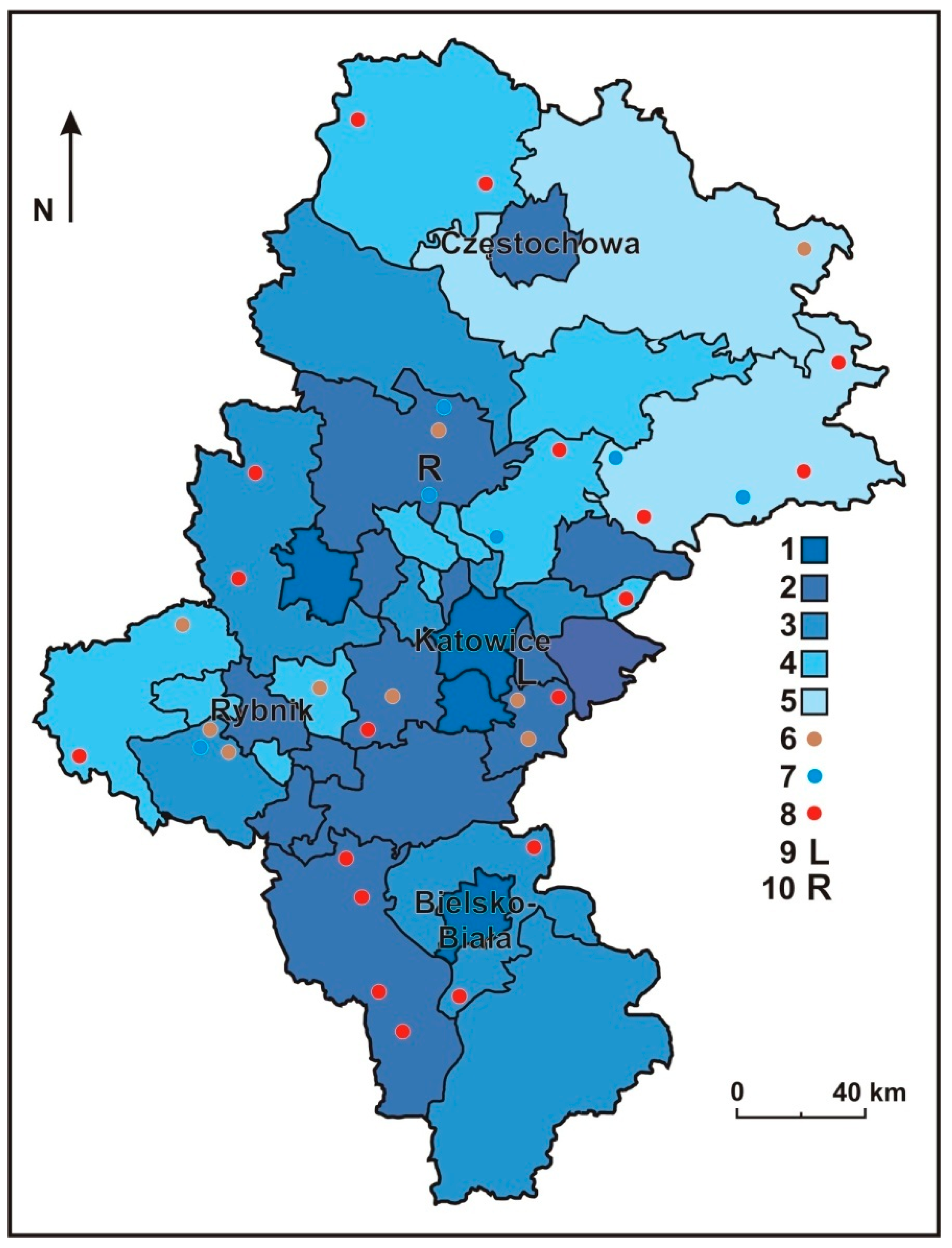
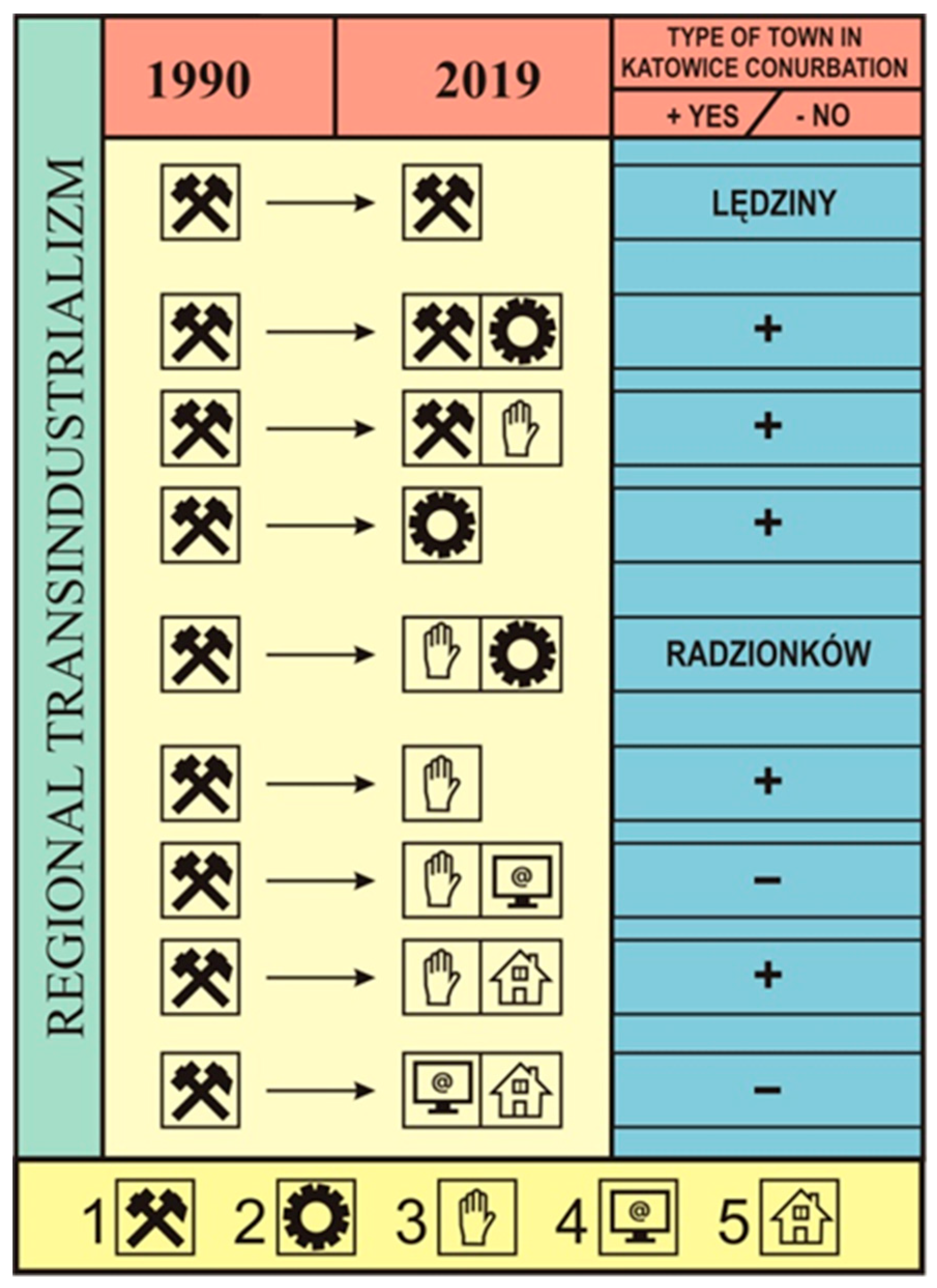
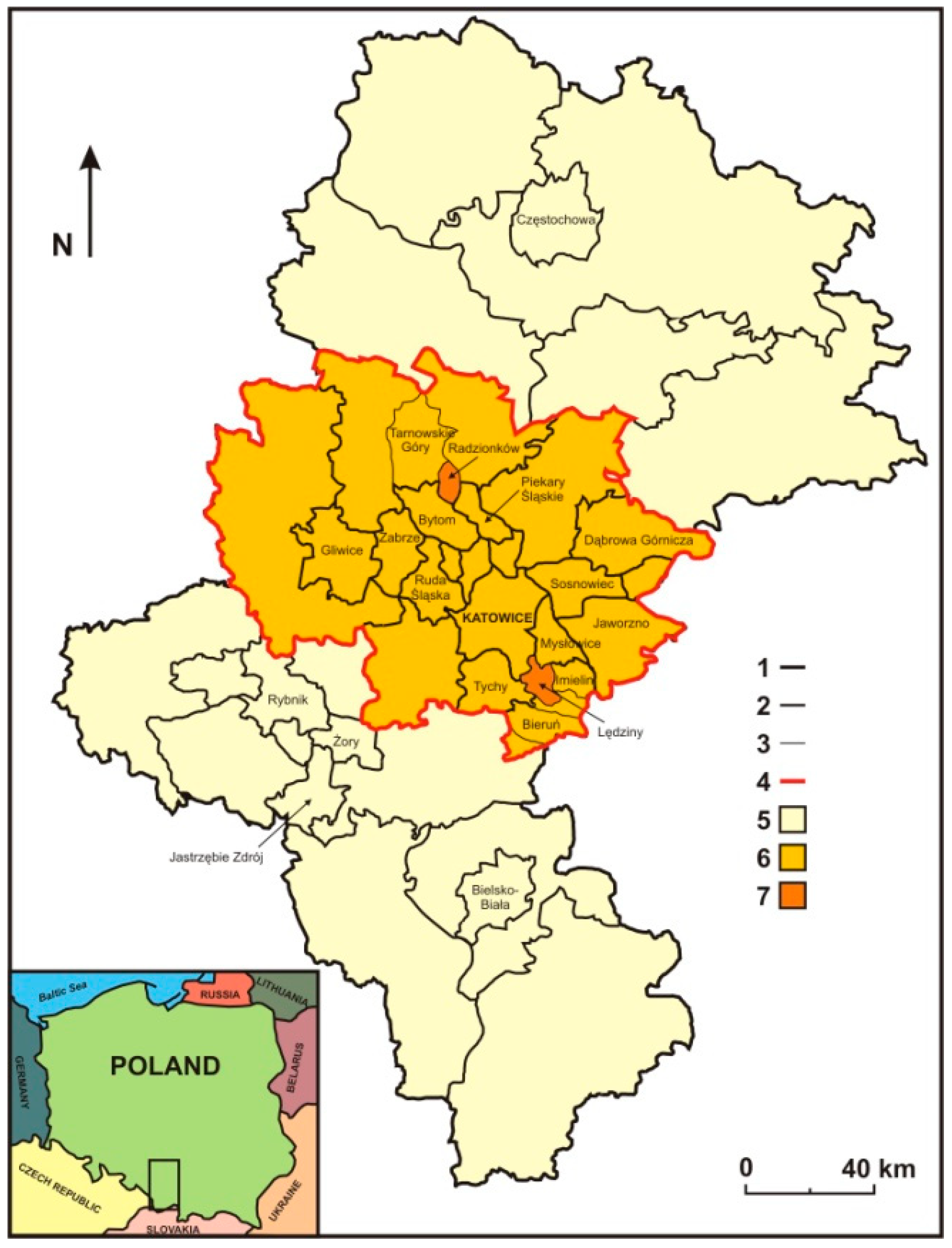
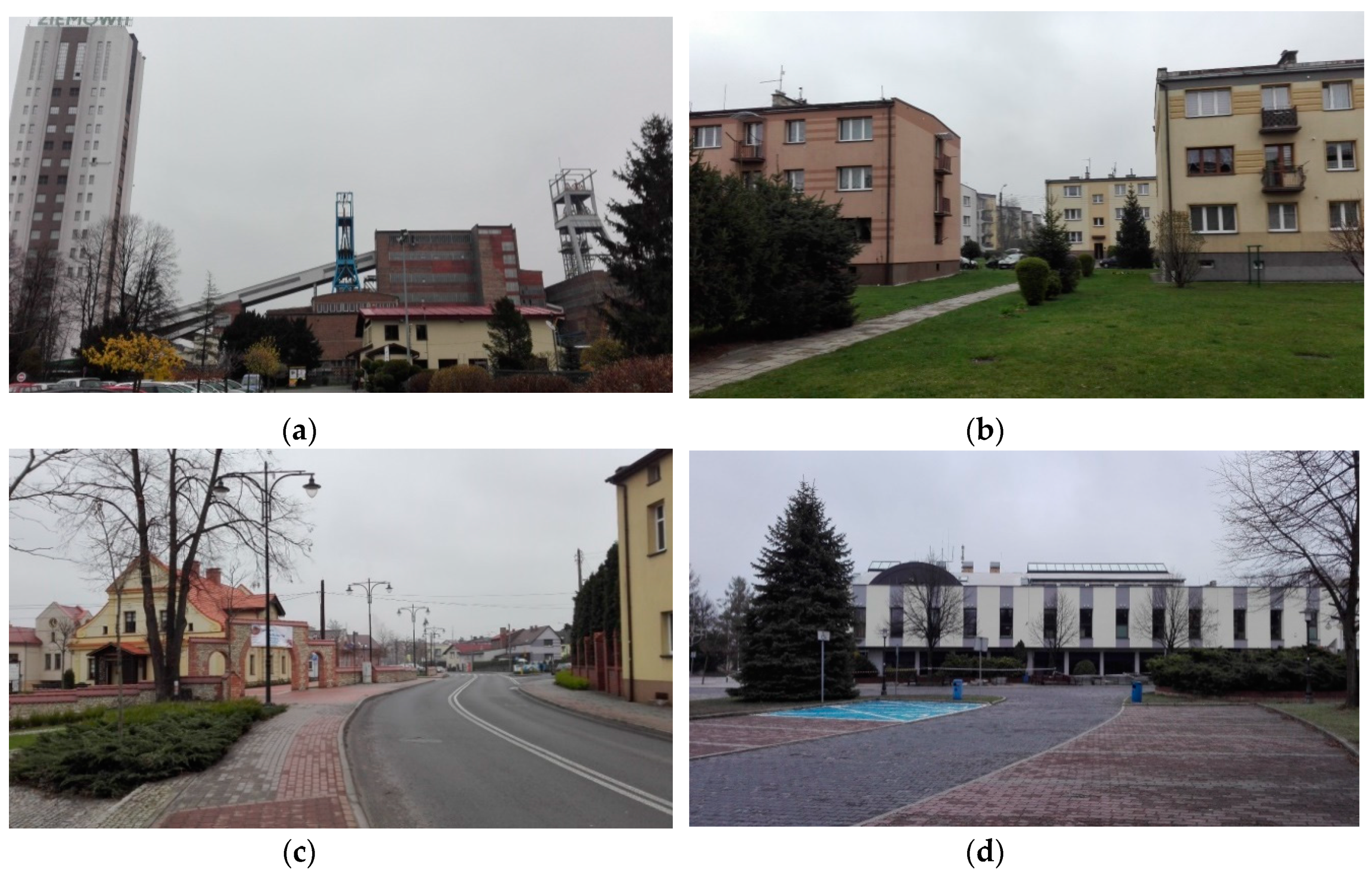
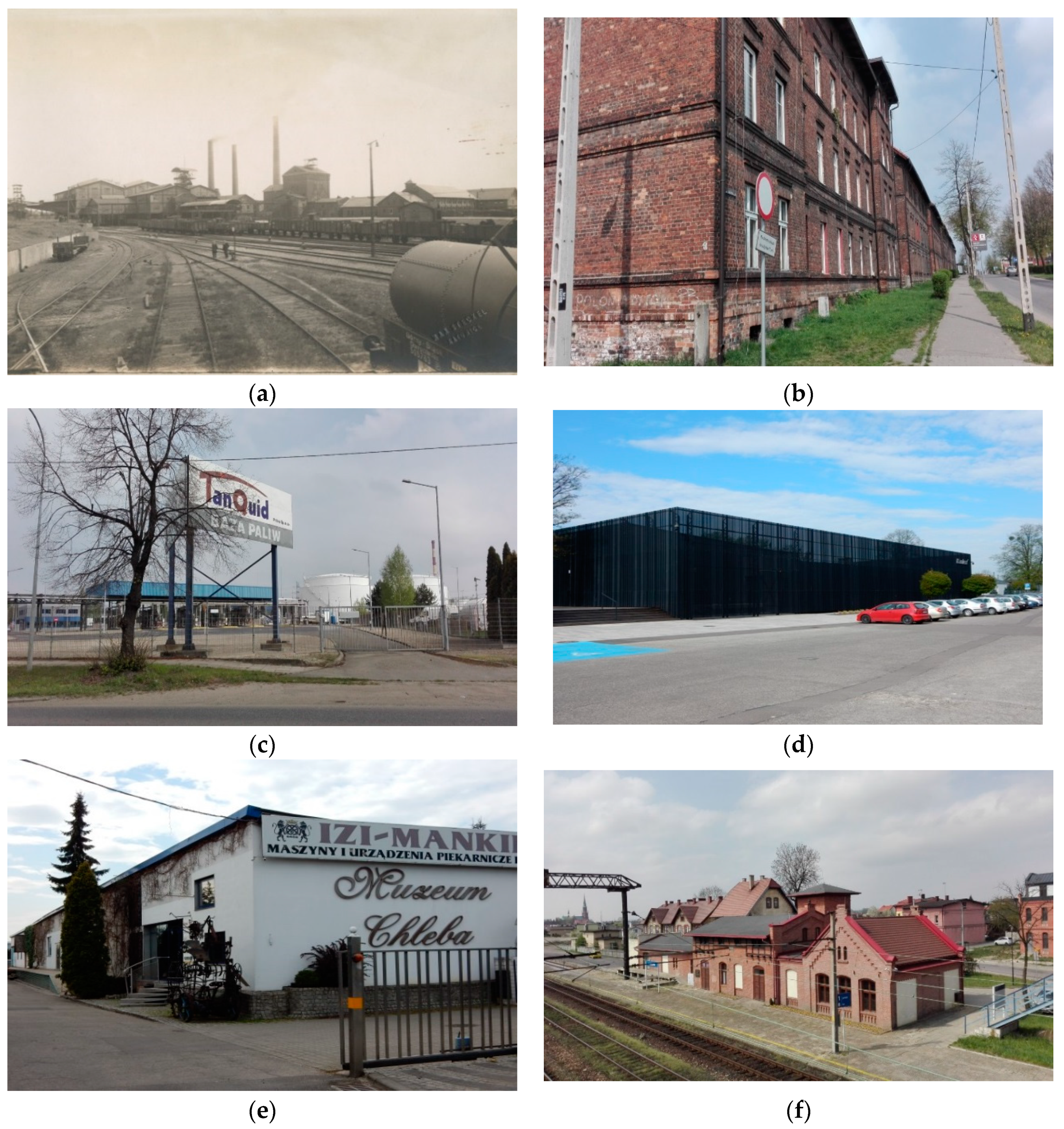
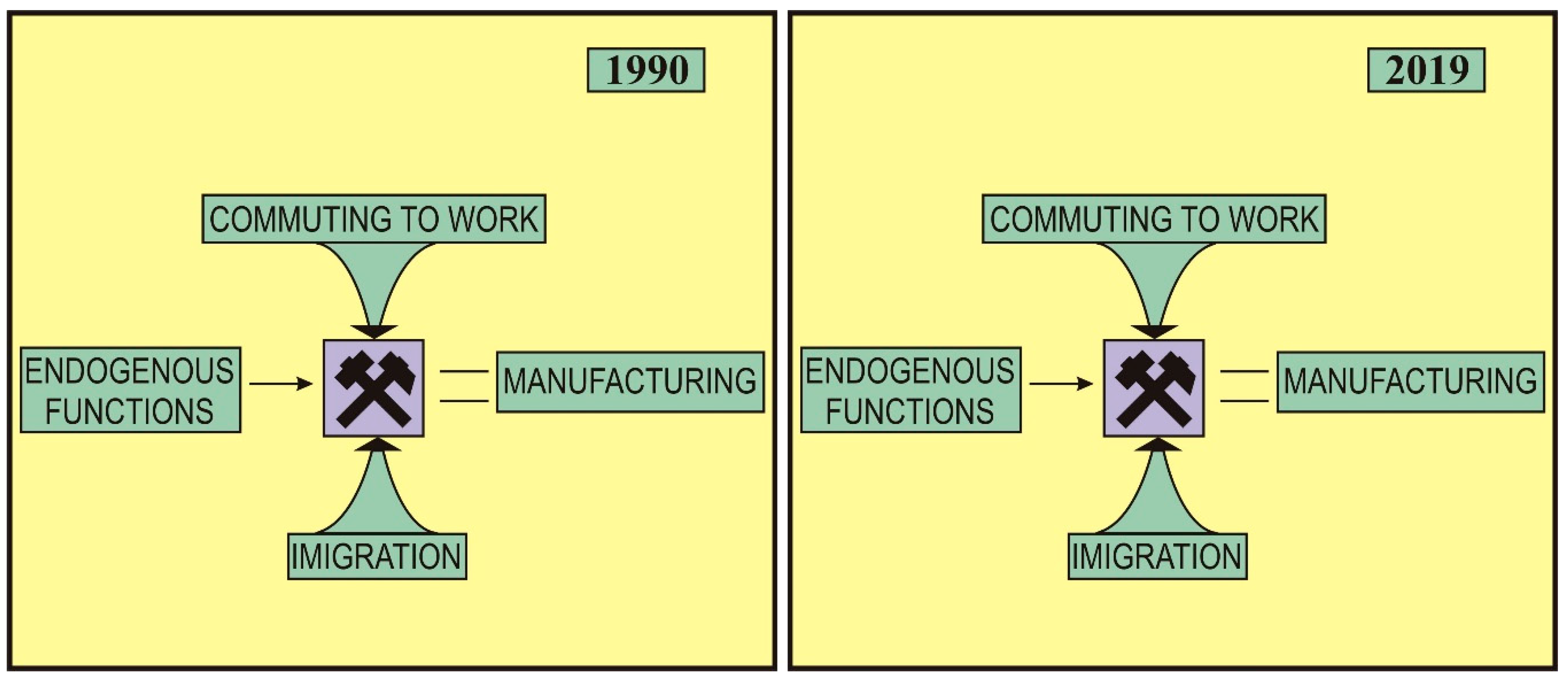

| Indicator/Feature | Lędziny | Radzionków |
|---|---|---|
| Social Indicators | ||
| marriages per 1000 population | 5.5 | 5.1 |
| divorces per 1000 population | 1.3 | 1.3 |
| live births per 1000 population | 12.6 | 10.0 |
| births to deaths ratio | 1.44 | 0.93 |
| deaths per 1000 population | 8.9 | 10.9 |
| pre-working age population (%) | 19.3 | 16.5 |
| working age population (%) | 64.4 | 61.3 |
| retirement age population (%) | 16.3 | 22.2 |
| natural increase | 57.0 | −16.0 |
| migration balance | −12.0 | −33.0 |
| Population dynamics 2000–2018 (%) | 3.30 | −2.11 |
| Percentage of students in 20–24 year age group (2012/2013) | 52.5 | 42.6 |
| Economic Indicators | ||
| Employed per 1000 inhab.* | 337 | 208 |
| Employment structure (in %) | ||
| agriculture | 0.2 | 0.2 |
| industry | 75.6 | 47.2 |
| services | 24.2 | 52.6 |
| Unemployed per 1000 inhab.* (2018) | 10.8 | 17.9 |
| Unemployed per 1000 employed (2018) | 31.0 | 83.4 |
| REGON-registered economic entities per 10,000 inhab. (2018) | 749 | 1014 |
| Town budget income per inhab. (in euros; National Bank of Poland exchange rate from May 8, 2019) | 913 | 1037 |
| Lędziny | Radzionków | ||
|---|---|---|---|
| From | To | From | To |
| Tychy (176) | Tychy (1074) | Bytom (778) | Bytom (657) |
| Mysłowice (136) | Katowice (399) | Tarnowskie Góry (304) | Katowice (456) |
| Chełm Śląski (72) | Bieruń (386) | Piekary Śląskie (265) | Tarnowskie Góry (420) |
| Imielin (68) | Mysłowice (225) | Świerklaniec (141) | Piekary Śląskie (265) |
| Bojszowy (37) | Bielsko-Biała (109) | Bobrowniki (53) | Gliwice (203) |
| Total (608) | Total (2608) | Total (1937) | Total (2703) |
| Issue | Answer By | |||
|---|---|---|---|---|
| Paper Questionnaire | Computer-Assisted Telephone Interviewing (CATI) | |||
| Number | % | Number | % | |
| I work in this town and I am happy with the place of life | 54 | 20.6 | 27 | 9.2 |
| Radzionków is a place where there are no jobs | 94 | 35.9 | 115 | 39.4 |
| This town is a place where there is no chance to make career | 64 | 24.4 | 88 | 30.1 |
| This town is a place where salaries are too small | 59 | 22.5 | 37 | 27.7 |
| There is not enough work for young people in Radzionków. | 175 | 66.8 | 147 | 50.5 |
| Type of Small Towns | Number of Towns | 2008 | 2018 | Dynamics of Population in % |
|---|---|---|---|---|
| Mining small towns | 7 | 118,528 | 119,303 | 0.7 |
| Resort small towns | 14 | 118,932 | 114,406 | −3.8 |
© 2019 by the authors. Licensee MDPI, Basel, Switzerland. This article is an open access article distributed under the terms and conditions of the Creative Commons Attribution (CC BY) license (http://creativecommons.org/licenses/by/4.0/).
Share and Cite
Krzysztofik, R.; Kantor-Pietraga, I.; Kłosowski, F. Between Industrialism and Postindustrialism—the Case of Small Towns in a Large Urban Region: The Katowice Conurbation, Poland. Urban Sci. 2019, 3, 68. https://doi.org/10.3390/urbansci3030068
Krzysztofik R, Kantor-Pietraga I, Kłosowski F. Between Industrialism and Postindustrialism—the Case of Small Towns in a Large Urban Region: The Katowice Conurbation, Poland. Urban Science. 2019; 3(3):68. https://doi.org/10.3390/urbansci3030068
Chicago/Turabian StyleKrzysztofik, Robert, Iwona Kantor-Pietraga, and Franciszek Kłosowski. 2019. "Between Industrialism and Postindustrialism—the Case of Small Towns in a Large Urban Region: The Katowice Conurbation, Poland" Urban Science 3, no. 3: 68. https://doi.org/10.3390/urbansci3030068
APA StyleKrzysztofik, R., Kantor-Pietraga, I., & Kłosowski, F. (2019). Between Industrialism and Postindustrialism—the Case of Small Towns in a Large Urban Region: The Katowice Conurbation, Poland. Urban Science, 3(3), 68. https://doi.org/10.3390/urbansci3030068






